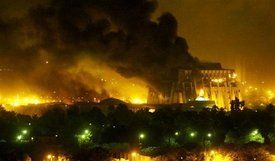A radioactive heavy metal found in weapons used by the U.S. military and other forces in the war on Iraq continues to plague the country as hundreds of sites are still contaminated and causing the spread of the radioactive substance, according to a new report by Netherlands peace group IKV Pax Christi.
Tens years after the invasion, the U.S. has done almost nothing to clean up the toxic legacy of the war and continues to deny the well-documented harms caused by the radioactive residue that remains.
The particular danger posed by depleted uranium (DU) - used in munitions to penetrate hard surfaces such as armored vehicles - was well know prior to the 2003 start of the war. Despite this and ignoring warnings against the continued use of DU munitions, the findings of the report show that both the U.S. and the U.K. used such weapons far more expansively in Iraq - targeting ordinary vehicles and buildings in highly populated civilian areas.
According to the report, In a State of Uncertainty: Impact and implications of the use of depleted uranium in Iraq, the US expended over 400 tonnes of DU ammunition in Iraq, both during the first Gulf War in the early 1990's and the subsequent invasion in 2003. British forces, reportedly, used three tonnes.
Both the U.S. and the U.K. have failed to admit the widely reported adverse health affects of exposure to DU. However, as the report points out:
In response to the report, a UK government spokeswoman told the Guardian, "While UK armed forces have not needed to use DU since 2003, it would be wrong to deny them the potential future use of a legitimate and effective capability."New and alarming reports of increased cancer rates and birth malformations emerged in the years after the official ending of the hostilities in Iraq, as well as amongst veterans of Coalition forces who were present during and after the fighting; which again pointed to the use of DU as the cause of these health problems.
The US government has consistently denied confirmation of where it had fired DU weapons. The report, however, shows that between 300 and 365 contaminated sites have been reported by 2006, with likely many more.
"It is unclear exactly how many locations may still be contaminated, or the extent of the risks that civilians face," said the report's author, Wim Zwijnenburg.
The report states:
The exposure risks to civilians from the use of DU in populated areas have been compounded by the US's persistent refusal to release the data that could have helped facilitate effective assessment and clearance work, providing that the Iraqi government had the capacity and finances to undertake it. Taken as a whole, these issues cast serious doubts over the legitimacy of the use of DU.




Reader Comments
to our Newsletter